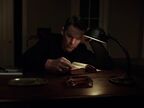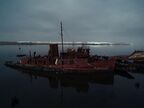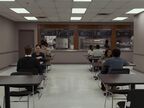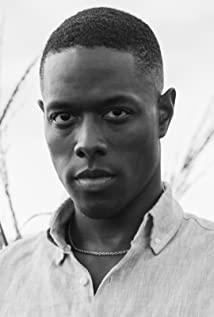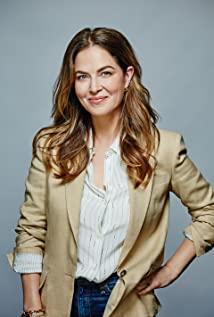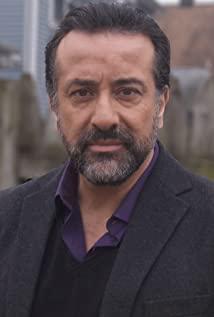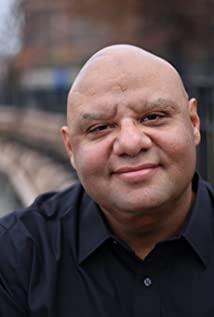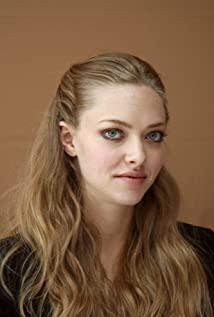The first time I heard the concept of "long shot" was when I was in my third year of high school. At that time, our head teacher, who was also a Chinese teacher, suddenly mentioned his five favorite movies at the end of a class. There seems to be one by Jia Zhangke, and I still remember his fascination with the "long-shot" beauty of that movie when he mentioned it. At that time, although I also watched movies, I was afraid that none of them could help me understand what a "long shot" is, so after listening to it, I was just a little curious, and it didn't resonate much.
Years later, my dabbling in literary films made me gradually perceive the power of long shots and "slow movies". Although I have been influenced by Kielovsky and Angelopoulos (these "forced" masters), what really touched me was the later "Beyond the Mountain". In this film, Mongy "stretches" time to the extreme, restoring us to the context of the film as much as possible. I still remember Voichita's back in the dark night. The camera quietly "watches" her, sharing the thoughts of this back, loneliness and silence. With every breath, we seem to be the sharply condensed air beside her.
Paul Schrader's new work "First Reformed" in 2017 made me experience such "air condensation" again. There are many kinds of slow movies, and "First Reformed" is similar to "Beyond the Mountain". It is not the magnificence of Tarkovsky, the color of Antonioni, or the delicacy of Hou Hsiao-hsien, but the coldness and sharpness of Mungi's lens. Therefore, the "slowness" of such films does not lie in conveying Ta's sympathy, An's romance, or Hou Dao's warmth, but starting from a small pattern to analyze the struggles and struggles of individuals under the pressure of society and the environment. get away". The priest Toller played by Ethan Hawke, like the nun Voichita, is fragile and helpless, self-closed, trying to break free, but timid and timid precisely because of kindness. The setting of the church, the social relationship between people (family and love is impossible to talk about), further intensifies the differences and confrontation between the reality and the spiritual world, and the tension behind the film's calmness also comes from this.
What impresses me is Schrader's rendering of the overall story atmosphere through shooting in this film. Although the method itself is not novel, it is very rare in today's American film environment. I think it is only such a seventy-year-old old man who has already passed the peak of his life that he has such confidence. At the beginning of the film, the camera moves to the First Reformed Church soothingly, looking up rather than looking up, as if to escape the original solemnity of the church, and the uneasiness revealed in the process of pushing the mirror sets the tone for the unfolding of the next story. Immediately cut to the interior, here is a bird's-eye view, from the second floor of the church to observe "everyone", the frame is frozen for a few seconds, and all the seats of the church can be seen, and the so-called "everyone" is actually a few visitors. They are scattered on the frame in front of you, and the delicate balance between the individual and the individual position is very similar to the classic garden freeze-frame scene in "Last Year at Marienbad", where some ambiguous emotional connection is superimposed. On top of the sparseness and loneliness on the surface, although there are no lines or voices, the emotions conveyed by the lens itself are rich and full. Then, Ethan Hawke walked out of the door on one side, stepped onto the podium, and began to preach.
Mary, a young woman played by Amanda Seyfried, experienced a similar emotional buildup in her appearance. A medium shot is on Father Toller and another middle-aged man, exchanging topics we can't remember now, and Mary stands by and waits silently. As the audience, we are also experiencing this kind of waiting together, and Schrader does not seem to be in a hurry to let the two protagonists' "playing" start a minute and a second earlier. This meaningless "waiting" in terms of plot promotion actually helps us understand the character of Mary in the shortest time. She is thin and thin in front of the tall door. Although we can't see the expression on her face in the medium shot, it is such a non-close-up shot that puts us into the heart of the character, making it more three-dimensional from the perspective of the environment. To speculate on Mary's mood at the time and the possible story behind it.
"First Reformed" adopts the 1.37:1 format, which is extremely rare in contemporary drama films. Such a frame is almost square, which makes the subject stand out more when aimed at the person, and is more restrained when depicting a space scene. As a deliberately chosen form, Schrader combines this with the "simplicity" of the set, the restraint of the background music, and the monotony of the tone, to present us the pale and sensitive reality and spirit of Father Toller. world. It is in such a frame that we spy on Toller's living space, a table with four legs, a chair and a glass of wine, and the two ends of the picture are cut off by the frame itself, which seems to tell us nothing else. In such a frame, we witness the entire conversation between Toller and extreme environmentalist Michael, two big men leaning against the edge of the picture, "crammed" under such an invisible "frame", exchanging very different values. This ten-minute-long dialogue is also one of my favorite passages in the film. It is also one of the few passages in this film that focuses on the "extreme emotions" of the characters' innermost feelings. , showing complete calm and respect for the characters and the topic itself.
Ethan Hawke himself once said, " The older you get, the humbler you get, the more life kind of rips you open and the more responsible you feel. " "The Schrader behind" couldn't be more appropriate. This film presents us with the perspective of such an "elder". In my eyes, the elders are not the same as the wise, because the wise will have a broader perspective in the process of pinching the characters and stories, and attempt to comment on one or two from a higher dimension. The old tower is a wise man, and so is Antonioni, but Schrader's "First Reformed" has no such ambition. It is actually very personal, because belief and spirituality are themselves a very personal thing. . Small individuals are far less "all-knowing" than God. Often times, the unfortunate personal situation, the lack of social relationships and emotions, the establishment and collapse of beliefs are just a single thought.
The end of the film is gripping but very peaceful. The church finally celebrates its 250th anniversary. Esther, played by Victoria Hill, walks to the front of the stage in place of the priest. A slow church chant "Leaning on the Everlasting Arms" slowly tells people The misfortune of the world, and the sacrifices, struggles and compromises that everyone makes for this. The other side of the "world" is separated by a wall. Our priest Toller is flustered, frightened, and at a loss. He does not know whether to advance or retreat in the angle between faith and life. The instinctive fear of tragedy makes us feel that time is slowing down in this moment because we want to know how it will end. Fortunately, Mary appeared at the right time to save Toller and us in front of the screen. The movie came to an abrupt end when the two of them hugged each other tightly, and the gentle chant was interrupted by the explosive "hard stop". It seemed that the "absent" God pressed the switch on the remote control. , dragging us back into darkness and reality.
Some people say that this is the best film Schrader has made in ten or twenty years. The film critic, the screenwriter behind "Taxi Driver" and "The Last Temptation of Christ", poured himself into the role of Father Toller. It is not only a reflection on personal experience and experience, but also includes the cognition and understanding of the artistic language of film itself. "The First Reformed" is far from a summary of Schrader's forty years of filming. He is just another "chatter" after a seventy-year-old man "crossed the hills", a Bresson and German A late homework handed to the "teacher" by a Layer admirer.
To conclude with Schrader's own assessment of the film:
“There are many kinds of slow cinema. I've been writing about this. There is the ultraslow cinema — making time a participant in the narrative. How long you watch these people becomes part of what you think about them. What do you think about when nothing happens? You think about something when nothing happens.”
View more about First Reformed reviews



